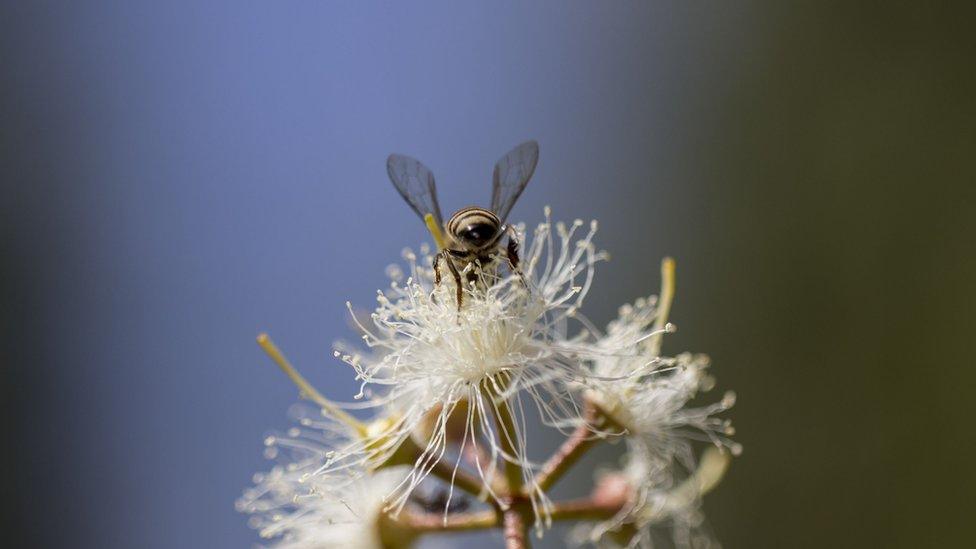UN: Growing threat to food from decline in biodiversity
- Published
- comments

The plants, animals, and micro-organisms that are the bedrock of food production are in decline, according to a UN study.
If these critical species are lost, the report says, it "places the future of our food system under severe threat".
The study says that land-use changes, pollution, and climate change are all causing biodiversity loss.
While species friendly policies are increasing, they are not growing quickly enough, the scientists add.
The UN's Food and Agriculture Organization (FAO), who've put the report together using data gathered in 91 countries, say it is the first such study of its kind.
What exactly is biodiversity for food and agriculture?
This is essentially the diversity of plants, animals, and other organisms, both wild and domesticated, that provide us with food, fuel and fibre.
And it includes those organisms that provide essential services, such as bees and other pollinators, and worms, mangroves, sea grasses and fungi which work to keep soils fertile and purify the air and water.
Why is this new report important?
The report, called the State of the World's Biodiversity for Food and Agriculture, external, highlights two key messages.
The first is that the world is relying on an ever smaller number of foodstuffs to feed a growing population that's expected to rise to around 10 billion people by 2050.
Of the 6,000 plant species cultivated for food, just nine account for 66% of total crop production. The world's livestock production is based on around 40 species with only a handful providing the vast majority of meat, milk and eggs.

The second key point is that many of these species that support food and agriculture are under threat or declining. Around a thousand wild food species, mainly plants, fish and mammals are decreasing in abundance.
"Biodiversity is critical for safeguarding global food security, underpinning healthy and nutritious diets, improving rural livelihoods, and enhancing the resilience of people and communities," said FAO's Director-General José Graziano da Silva.
"We need to use biodiversity in a sustainable way, so that we can better respond to rising climate change challenges and produce food in a way that doesn't harm our environment."
So what is the scale of threat to our food?
According to the study, the lack of biodiversity can leave food production much more vulnerable to shocks, such as outbreaks of disease and pests.
The report highlights what can happen in worst-case scenarios like the Irish potato famine of the 1840s.

A red-eyed tree frog in Costa Rica
As Irish tenant farmers used their land to mainly grow grain to pay their rents, they became increasingly dependent on the potato as their main source of sustenance.
When a disease caused by a fungus destroyed the potato crop for several years in a row, it led to the the deaths of a million people from starvation and illness.

While nothing on the scale of famine is now predicted, the new study highlights a number of examples where the loss of biodiversity is impacting people's lives and diets.
The Gambia says that large losses of wild foods have forced communities to turn to industrially processed foods to supplement their diets
Several countries including Ireland, Norway, Poland and Switzerland report declines in bumblebees.
In Oman, the loss of pollinator populations due to extreme heat associated with climate change has seen the decline of wild food, including figs and berries.
So what's causing the decline?
The report says that there are several significant causes or drivers of biodiversity loss. The main ones are:
Changes in land and water use and management
Pollution
Overexploitation and overharvesting
Climate change
Population growth and urbanisation
"We see that in the tropics and sub-tropics the expansion of large scale agriculture accounted for 40% of forest loss between 2010 and 2015," said Julie Belanger, who co-ordinated the report for the FAO.
"Other major negative drivers that countries reported include climate change, pollution and inappropriate use of inputs as well as overexploitation."

Are there any effective solutions to this?
Yes - the report highlights a number of what it terms "biodiversity friendly practices" that are on the rise. Some 80% of the countries reporting say that they follow one or more of these approaches. Some examples include:
In Argentina, some 560,000 home gardens and 12,000 school and community gardens have been created and are providing food for an estimated 2.8 million people
In California, farmers are now allowing their rice fields to be flooded after harvest instead of burning them, opening 111,000 hectares of surrogate wetlands and open space for 230 bird species.
Farmers in Ghana are planting cassava plants on field margins which produce huge amounts of nectar, attracting bees and other species, leading to higher yields.
While these are lauded, the problem according to the FAO is that these changes aren't happening quickly enough.
"It is very positive to see that countries are adopting more and more practices that contribute to sustainable food production across the globe," said Julie Belanger. "However, sometimes increased adoption is coming from a very low starting point indeed."
What can I do in my own life to change this?
In common with many environmental problems, consumers have enormous power to drive change.
The FAO says that the general public can opt for more sustainably grown products from farmers' markets, for example, or boycott foods that are seen to be unsustainable.

"Something that came out strongly was the importance of the role of citizen scientists," said Julie Belanger.
"People who are involved in volunteer work for biodiversity-monitoring and also for conservation work - these are playing a very important role in a number of countries."
Follow Matt on Twitter @mattmcgrathbbc, external